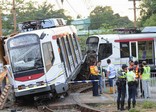
MOSCOW, May 18 (Xinhua) -- Braving the weekend's four-hour traffic jams, dozens of cars are heading southeast of Moscow toward a unique open-air museum in the Kaluga region.
"My 9-year-old son has heard from his friends that this is the place where one can experience a real life of many nations," said Yelena who drives her family sedan. "So I decided to see that magical place with my own eyes."
The Etnomir (Ethnic World) Park exceeded their expectations, she said six hours later.
"We have visited Chinese, Middle-Eastern, European, South-African villages. But most of all I loved the Baltic quarter. I felt myself there returning home," said Yelena, who along with her husband is of Lithuanian descent.
Etnomir is just one example of the emerging trend in Russian museum business: interactive establishments which combine entertainment and education with enlightenment.
Maria Baryshnikova, one of the Etnomir managers, said the educational center started as a private hobby of a Kazakh entrepreneur who wanted to reconstruct the landscape of his native country.
Later he decided to convert it into a "world in a nutshell," and the idea was supported by federal and regional authorities, Baryshnikova said.
Museums used to serve as memory collection stores for the society. Those presented inside the display windows are part of the "untouchable" history: dated, defined, and demode.
Indeed, the history of museum in Russia itself is relatively brief, with the first one established by Peter the Great in the 18th century. Russia's first museum, Hermitage in St. Petersburg, still remains the largest in the country.
As Russia gradually evolved into a major European power, Tsars wanted to influence world affairs with the evidence of Russia's historical and cultural supremacy.
Museums in St. Petersburg (then Leningrad) became a symbol of its residents' high spirit during the 900 days of blockade in the World War II.
The Nazi invaders were stunned to learn through their intelligence that the city authorities, while people were dying from hunger in thousands, still kept their museums, libraries and concert halls open for public.
War and hunger were unable to shake the museums in Russia. The social and economic reforms in the 1990s managed to do what the invaders failed in the 1940s.
 |
















 Deaths prompt concerns over elevator safety
Deaths prompt concerns over elevator safety


![]()
